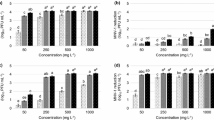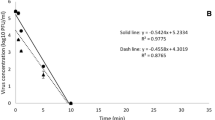Abstract
The aim of this study was to investigate the effect of relative humidity (RH) and temperature on norovirus (NoV) persistence as infectious particles on food-contact surfaces such as stainless steel and polyvinyl chloride (PVC). For this purpose, a new method combining enzymatic digestion with molecular beacon-based NASBA targeting the ORF1-ORF2 domain was developed to discriminate between infectious and noninfectious NoV. Stainless steel and PVC disks were contaminated with known amounts of human NoV and kept for 56 days at 7 and 20°C at high (86% ± 4%) and low (30% ± 10%) RH. NoV retained its putative infectivity for 56 days on PVC and for 49 days on stainless steel at 7°C and for 7 and 28 days, respectively, at low and high RH at 20°C on both tested surfaces. These results confirm that NoV persists in an infective state on inert surfaces for long periods of time and consequently may cause illness. The new molecular approach to detecting infectious NoV on inert surfaces may provide valuable information for evaluating environmental surface decontamination strategies.



Similar content being viewed by others
References
Abad, F. X., Pinto, R. M., & Bosch, A. (1994). Survival of enteric viruses on environmental fomites. Applied and Environmental Microbiology, 60, 3704–3710.
Boone, S. A., & Gerba, C. P. (2007). Significance of fomites in the spread of respiratory and enteric viral disease. Applied and Environmental Microbiology, 73, 1687–1696.
Cannon, J. L., Papafragkou, E., Park, G. W., Osborne, J., Jaykus, L. A., & Vinje, J. (2006). Surrogates for the study of norovirus stability and inactivation in the environment: A comparison of murine norovirus and feline calicivirus. Journal of Food Protection, 69, 2761–2765.
Clay, S., Maherchandani, S., Malik, Y. S., & Goyal, S. M. (2006). Survival on uncommon fomites of feline calicivirus, a surrogate of noroviruses. American Journal of Infection Control, 34, 41–43.
Daniels, N. A., Bergmire-Sweat, D. A., Schwab, K. J., Hendricks, K. A., Reddy, S., Rowe, S. M., et al. (2000). A foodborne outbreak of gastroenteritis associated with Norwalk-like viruses: First molecular traceback to deli sandwiches contaminated during preparation. Journal of Infectious Diseases, 181, 1467–1470.
Doultree, J. C., Druce, J. D., Birch, C. J., Bowden, D. S., & Marshall, J. A. (1999). Inactivation of feline calicivirus, a Norwalk virus surrogate. Journal of Hospital Infection, 41, 51–57.
D’Souza, D. H., Sair, A., Williams, K., Papafragkou, E., Jean, J., Moore, C., et al. (2006). Persistence of caliciviruses on environmental surfaces and their transfer to food. International Journal of Food Microbiology, 108, 84–91.
Gassilloud, B., Schwartzbrod, L., & Gantzer, C. (2003). Presence of viral genomes in mineral water: A sufficient condition to assume infectious risk? Applied and Environmental Microbiology, 69, 3965–3969.
Glass, R. I., Noel, J., Ando, T., Fankhauser, R., Belliot, G., Mounts, A., et al. (2000). The epidemiology of enteric caliciviruses from humans: A reassessment using new diagnostics. Journal of Infectious Diseases, 181(Suppl 2), S254–S261.
Green, J., Wright, P. A., Gallimore, C. I., Mitchell, O., Morgan-Capner, P., & Brown, D. W. (1998). The role of environmental contamination with small round structured viruses in a hospital outbreak investigated by reverse-transcriptase polymerase chain reaction assay. Journal of Hospital Infection, 39, 39–45.
Green, K. Y., Belliot, G., Taylor, J. L., Valdesuso, J., Lew, J. F., Kapikian, A. Z., et al. (2002). A predominant role for Norwalk-like viruses as agents of epidemic gastroenteritis in Maryland nursing homes for the elderly. Journal of Infectious Diseases, 185, 133–146.
Gulati, B. R., Allwood, P. B., Hedberg, C. W., & Goyal, S. M. (2001). Efficacy of commonly used disinfectants for the inactivation of calicivirus on strawberry, lettuce, and a food-contact surface. Journal of Food Protection, 64, 1430–1434.
Hewitt, J., & Greening, G. E. (2004). Survival and persistence of norovirus, hepatitis A virus, and feline calicivirus in marinated mussels. Journal of Food Protection, 67, 1743–1750.
Jones, E. L., Kramer, A., Gaither, M., & Gerba, C. P. (2007). Role of fomite contamination during an outbreak of norovirus on houseboats. International Journal of Environmental Health Research, 17, 123–131.
Jothikumar, N., Lowther, J. A., Henshilwood, K., Lees, D. N., Hill, V. R., & Vinje, J. (2005). Rapid and sensitive detection of noroviruses by using TaqMan-based one-step reverse transcription-PCR assays and application to naturally contaminated shellfish samples. Applied and Environmental Microbiology, 71, 1870–1875.
Kageyama, T., Shinohara, M., Uchida, K., Fukushi, S., Hoshino, F. B., Kojima, S., et al. (2004). Coexistence of multiple genotypes, including newly identified genotypes, in outbreaks of gastroenteritis due to Norovirus in Japan. Journal of Clinical Microbiology, 42, 2988–2995.
Katayama, K., Shirato-Horikoshi, H., Kojima, S., Kageyama, T., Oka, T., Hoshino, F., et al. (2002). Phylogenetic analysis of the complete genome of 18 Norwalk-like viruses. Virology, 299, 225–239.
Koopmans, M., von Bonsdorff, C. H., Vinje, J., de Medici, D., & Monroe, S. (2002). Foodborne viruses. FEMS (Federation of European Microbiological Societies) Microbiology Reviews, 26, 187–205.
Lamhoujeb, S., Fliss, I., Ngazoa, S. E., & Jean, J. (2008). Evaluation of the persistence of infectious human noroviruses on food surfaces using molecular beacon-based nucleic acid sequence-based amplification. Applied and Environmental Microbiology, 74(11), 3349–3355.
Lopman, B. A., Adak, G. K., Reacher, M. H., & Brown, D. W. (2003a). Two epidemiologic patterns of norovirus outbreaks: Surveillance in England and Wales, 1992–2000. Emerging Infectious Diseases, 9, 71–77.
Lopman, B. A., Reacher, M. H., Van Duijnhoven, Y., Hanon, F. X., Brown, D., & Koopmans, M. (2003b). Viral gastroenteritis outbreaks in Europe, 1995–2000. Emerging Infectious Diseases, 9, 90–96.
Mattison, K., Karthikeyan, K., Abebe, M., Malik, N., Sattar, S. A., Farber, J. M., et al. (2007). Survival of calicivirus in foods and on surfaces: Experiments with feline calicivirus as a surrogate for norovirus. Journal of Food Protection, 70, 500–503.
Mbithi, J. N., Springthorpe, V. S., & Sattar, S. A. (1991). Effect of relative humidity and air temperature on survival of hepatitis A virus on environmental surfaces. Applied and Environmental Microbiology, 57, 1394–1399.
Moe, K., & Shirley, J. A. (1982). The effects of relative humidity and temperature on the survival of human rotavirus in faeces. Archives of Virology, 72, 179–186.
Nuanualsuwan, S., & Cliver, D. O. (2002). Pretreatment to avoid positive RT-PCR results with inactivated viruses. Journal of Virological Methods, 104, 217–225.
Richards, G. P. (1999). Limitations of molecular biological techniques for assessing the virological safety of foods. Journal of Food Protection, 62, 691–697.
Rzeżutka, A., & Cook, N. (2004). Survival of human enteric viruses in the environment and food. FEMS (Federation of European Microbiological Societies) Microbiology Reviews, 28, 441–453.
Sattar, S. A., Lloyd-Evans, N., Springthorpe, V. S., & Nair, R. C. (1986). Institutional outbreaks of rotavirus diarrhoea: Potential role of fomites and environmental surfaces as vehicles for virus transmission. The Journal of Hygiene, 96, 277–289.
Straub, T. M., Höner zu Bentrup, K., Orosz-Coghlan, P., Dohnalkova, A., Mayer, B. K., Bartholomew, R. A., et al. (2007). In vitro cell culture infectivity assay for human noroviruses. Emerging Infectious Diseases, 13, 396–403.
Ward, R. L., & Ashley, C. S. (1977). Inactivation of enteric viruses in wastewater sludge through dewatering by evaporation. Applied and Environmental Microbiology, 34, 564–570.
Wu, H. M., Fornek, M., Schwab, K. J., Chapin, A. R., Gibson, K., Schwab, E., et al. (2005). A norovirus outbreak at a long-term-care facility: The role of environmental surface contamination. Infection Control and Hospital Epidemiology, 26, 802–810.
Acknowledgments
The authors thank Dr. Stephen Davids for critical reading of the manuscript. This study was funded by the Natural Sciences and Engineering Research Council of Canada (NSERC) and the Fonds Québécois de la Recherche sur la Nature et les Technologies (FQRNT).
Author information
Authors and Affiliations
Corresponding author
Rights and permissions
About this article
Cite this article
Lamhoujeb, S., Fliss, I., Ngazoa, S.E. et al. Molecular Study of the Persistence of Infectious Human Norovirus on Food-Contact Surfaces. Food Environ Virol 1, 51–56 (2009). https://doi.org/10.1007/s12560-009-9010-0
Received:
Accepted:
Published:
Issue Date:
DOI: https://doi.org/10.1007/s12560-009-9010-0




